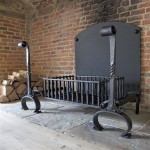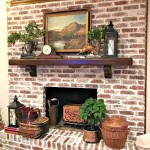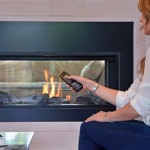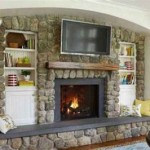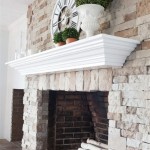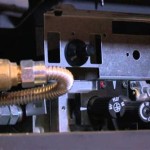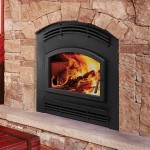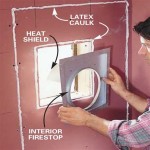Mounting a TV Over a Ventless Gas Fireplace: Considerations and Best Practices
The practice of mounting a television above a fireplace, particularly a ventless gas fireplace, has become increasingly popular in modern home design. This configuration offers a space-saving solution and creates a focal point within a room. However, integrating these two appliances requires careful consideration of safety, functionality, and aesthetics.
Ventless gas fireplaces, also known as vent-free fireplaces, differ significantly from traditional wood-burning or vented gas fireplaces. They operate by burning natural gas or propane with a high degree of efficiency, eliminating the need for a chimney or external venting system. This efficiency means that the combustion process releases heat directly into the room, along with water vapor and small amounts of carbon monoxide. The absence of ventilation is the primary factor that distinguishes them and subsequently influences the feasibility of mounting a television above them.
The primary concern when mounting a TV above any fireplace is heat. Excessive heat can damage the sensitive electronic components within a television, shortening its lifespan and potentially causing irreversible damage. The heat output of a ventless gas fireplace, combined with its proximity to the television, poses a considerable risk. Therefore, understanding the specific characteristics of the fireplace and the television is paramount before proceeding with installation.
Understanding Heat Output and Television Tolerance
The first step in determining the feasibility of mounting a TV above a ventless gas fireplace involves understanding the fireplace’s heat output. This is typically measured in British Thermal Units (BTUs) per hour and can be found in the fireplace’s specifications. A higher BTU rating indicates a greater heat output. It's important to note that the BTU rating reflects the maximum heat output, and the actual heat experienced above the fireplace will vary depending on factors such as the fireplace's settings, the room's size, and the ambient temperature.
Simultaneously, it’s crucial to understand the television's operating temperature range, which is usually provided in the manufacturer's specifications. Most televisions are designed to operate within a relatively narrow temperature range, typically between 32°F (0°C) and 104°F (40°C). Exceeding this range can lead to performance issues, damage to the screen, and premature failure of internal components.
Comparing the fireplace's heat output with the television's temperature tolerance is the first step. However, it's insufficient on its own. A crucial element is to measure the actual temperature above the fireplace during operation. This can be achieved using a temperature gun or a thermal imaging camera. These tools allow for accurate measurement of the surface temperature of the wall above the fireplace, providing a realistic indication of the heat the television will be exposed to.
If the temperature above the fireplace consistently exceeds the television's maximum operating temperature, alternative mounting locations should be explored. Continuing with the installation in such a scenario would likely result in damage to the television.
The Importance of Mantels and Heat Shields
In situations where mounting a TV above a ventless gas fireplace is desirable but the heat output poses a concern, incorporating a mantel or heat shield can significantly mitigate the risk. A mantel acts as a physical barrier, deflecting heat away from the wall and the television. The effectiveness of a mantel depends on its depth, material, and design.
A deeper mantel offers better heat deflection compared to a shallow one. The material of the mantel also plays a crucial role. Non-combustible materials like concrete, brick, stone, or metal are preferred, as they can withstand high temperatures without igniting or releasing harmful fumes. Wood can be used, but it needs to be properly treated with a fire-retardant coating and should be thick enough to provide adequate insulation. The design of the mantel should also promote airflow, allowing heat to dissipate rather than becoming trapped.
In addition to a mantel, a heat shield can provide an extra layer of protection. Heat shields are typically made of metal and are installed above the fireplace, creating an air gap between the fireplace and the wall. This air gap acts as an insulator, preventing heat from directly transferring to the wall and the television. The effectiveness of a heat shield is determined by its size, the material it's made from, and the size of the air gap. It is essential to ensure the heat shield is properly installed and securely fastened to the wall.
Even with a mantel and a heat shield, continuous monitoring of the temperature above the fireplace is essential during initial use. This allows for adjustments to be made to the fireplace's settings or the addition of further protective measures if needed.
Ventilation Considerations and Carbon Monoxide Safety
While ventless gas fireplaces are designed to burn fuel efficiently, they do produce small amounts of carbon monoxide (CO). Carbon monoxide is a colorless, odorless, and poisonous gas that can be harmful or even fatal if inhaled in high concentrations. Because ventless fireplaces do not have a chimney to vent these gases outside, it's crucial to ensure adequate ventilation in the room where the fireplace is installed.
Local building codes typically specify the minimum room size and ceiling height requirements for ventless gas fireplaces to ensure sufficient ventilation. Adhering to these codes is essential for safety. Additionally, it is strongly recommended to install a carbon monoxide detector in the room. The carbon monoxide detector will alert occupants if CO levels become dangerously high, providing an early warning system. Regular inspection and maintenance of the fireplace are also essential to ensure it is operating safely and efficiently.
Regarding the television, while the ventilation requirements for the room are primarily focused on human safety, proper airflow around the television itself is also beneficial. Ensuring that the back of the television is not obstructed and that there is adequate space for air to circulate around the unit will help to prevent overheating and prolong its lifespan.
Mounting a TV above a ventless gas fireplace requires a thorough assessment of heat output, temperature tolerance, and ventilation considerations. Proper installation of mantels and heat shields, combined with continuous monitoring and adherence to safety guidelines, can help to mitigate the risks associated with this configuration. While the aesthetics of a TV above a fireplace can be appealing, safety and functionality should always be the primary concerns.
The distance the television is from the heat source is important to consider when planning the television mount. The further away, the less exposure to heat the television will have. Many professionals suggest at least 12 inches of clearance between the top of the fireplace and the bottom of the television. This distance combined with a proper mantle can help create a buffer zone from the heat generated by the fireplace
Always consult with qualified professionals, such as HVAC technicians and electricians, before proceeding with the installation. These professionals can provide expert advice and ensure that the installation is done safely and in accordance with local building codes. Doing so will ensure the combination of a television and a ventless gas fireplace remains a safe and enjoyable feature within the home.
Beyond the physical considerations, maintaining the television's warranty should be considered. Many warranties contain clauses that exclude damage caused by excessive heat. Installing a television above a fireplace, even with precautions, could potentially void the warranty if heat-related damage occurs. Therefore, it's prudent to review the television's warranty terms carefully before proceeding with the installation.
Ultimately, the decision to mount a TV above a ventless gas fireplace is a personal one. However, it should be based on a thorough understanding of the associated risks and a commitment to implementing appropriate safety measures. By prioritizing safety and functionality, homeowners can create a beautiful and comfortable living space without compromising the longevity of electronic devices or the well-being of occupants.

Can I Hang A Tv Over My Fireplace Woodlanddirect Com

Mounting A Tv Over Fireplace Hearthcabinet

Can I Mount My Tv Above The Fireplace

ᑕ❶ᑐ What To Consider Before Mounting A Tv Above Fireplace

Can I Mount My Tv Above The Fireplace

Can I Hang A Tv Over My Fireplace Woodlanddirect Com

A Tv Over The Fireplace Design Yes Or Major No Our Fifth House

ᑕ❶ᑐ What To Consider Before Mounting A Tv Above Fireplace

Mounting Your Tv Above Fireplace

ᑕ❶ᑐ What To Consider Before Mounting A Tv Above Fireplace
Related Posts

